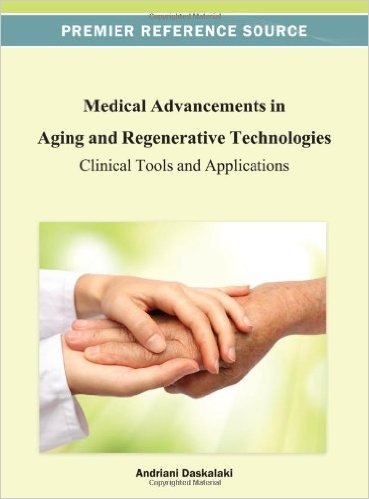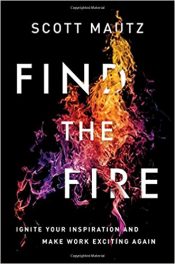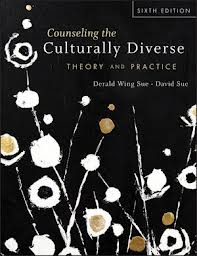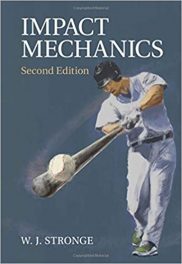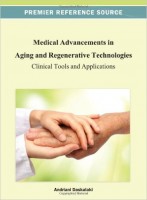 Editor: Andriani Daskalaki
Editor: Andriani Daskalaki
Publisher: Medical Information Science Reference – an Imprint of IGI Global – 598 pages
Book Review by: Hiro Motiram
Regenerative medicine is a relatively newer specialty among researchers, but quite exciting for them (especially in recent years) and very beneficial for mankind. Numerous new discoveries in tissue and organ rejuvenation have helped slow down the aging process and enabled people to enjoy more vigorous lives (it has been said that it’s not just the years in your life but the life in your years that is important). But the most rewarding outcome of such research is that the average life span has expanded, especially in developed countries.
Wikipedia provides information on particular people who have lived past 100 years in past millennia such as 103 years in 1798, 110 years in 1898, and the French woman Jeanne Clement who lived to be 122 years old. She was the world’s oldest known living person until her passing away in 1997.
And a news item in today’s (November 25, 2015) London Daily Mail entitled Could Your Child Live to Be 150 Years Old mentioned that a child born today does have a 40 percent chance of living to be 150 years old. This puts hope on the side of young people who want to enjoy life for a much longer period than anyone has lived so far in the history of humans.
I believe that to the average person, what matters more is not who have lived over 100 years of age, but the average life expectancy in a given country, which is affected by healthful living standards and the quality and availability of health care services.
According to 2013 statistics of the World Health Organization, Angola and Zambia had the lowest life expectancy among 222 countries, with the average person in both these places living up to 38 years of age. On the other end of the scale were Hong Kong and Japan where the average resident was living to be 84 years old.
These were followed by those who lived to be 83 years old and they were residents of seven countries: Andorra, Australia, Italy, San Marino, Singapore, Spain, and Switzerland. The United States also held a high position: it was 34th with the average person living to be 79 years old. The people of the world’s most populous country China were No. 67, and also had a relatively lengthy span of 75 years of age. India was No. 139 with average life expectancy of 66 years.
This book is about the ongoing research in many areas to find that “fountain of youth,” or more aptly, the various fountains, within the cells of our bodies.
Forty-three people from Germany and 14 other countries – Australia, Bulgaria, Canada, China, Germany, Greece, Italy, the Netherlands, Pakistan, Spain, Sweden, the United Kingdom, the United States, and Vietnam – are in one way or another involved in research on, or promulgation of medical advancements in the field of aging and its causes. They have authored the nine chapters, with three sections, of this pioneering work, as listed below:
- Aging and Regeneration: Basic Concepts in Medicine
- BMP Signaling in Regenerative Medicine
- Proliferation and Regeneration: Methodologies in Cancer Treatment and Post-Tissue Reconstruction
- Modeling Colorectal Cancer: A Stability Analysis Report
- Gene Expression Regulation Underlying Osteo-, Adipo-, and Chondro-Genic Lineage Commitment of Human Mesenchymal Stem Cells
- Basic Research: A Bridge Between Aging and Regeneration
- Immunogenicity of Stem Cells
- Regulatory T-Cell-Based Immunotherapy: Prospects of Antigen-Specific Tolerance Induction
- Regeneration of Articular Cartilage: Opportunities, Challenges, and Perspectives
- Generation of Scaffold-Free 3-D Cartilage-Like Microtissues from Human Chondrocytes
- The Hidden Markov Brains
- Regeneration and Aging: Applications in Medicine and Dentistry
- Designing Biomedical Stents for Vascular Therapy: Current Perspectives and Future Promises
- Heart Valve Diseases in the Elderly: Current Treatments and Future Directions
- Tactile Resonance Sensors for Detection and Diagnosis of Age-Related Diseases
- Dental Tissue Engineering Research and Translational Approaches towards Clinical Application
- Can Activated Platelet-Rich Plasma Combined with Adipose-Derived Stem Cells Be Used to Treat Skin Wrinkles? A Mechanism Study
The contributing authors are: doctors, engineers, professors, researchers, and scientists. They work in classrooms, companies, hospitals, laboratories, and universities and their areas of interest are numerous: biology (including biochemistry, bioinformatics, and biomedical engineering), chemistry, dentistry, engineering with many specialties, genetics, medicine, physics, veterinary medicine and other fields.
The editor of this volume Andriani Daskalaki, a dentist and specialist in bioinformatics who has done research in photodynamic theory and has authored six books, writes that this book essentially looks at the basic mechanisms associated with the process of aging and the tools and techniques that are used in closely studying and understanding that process.
What is aging? Why do humans slow down in physical activity, and become more prone to disease? Dr. Daskalaki defines aging as “a process guided by a large number of signaling molecules and gene regulatory factors acting to establish specific gene expression patterns.” She points out that we still do not know, or at least do not know enough, about “the mechanisms that lead to impaired healing with increasing age.”
Those molecular and signaling mechanisms underlying the aging process are being looked at closely by today’s research teams, which will help lead to “novel approaches of preventing and treating age-related diseases.” She points out that “a combination of high throughput approaches and advanced computational techniques to dissect the molecular mechanisms of stem cell fate and cellular reprogramming are applied in regenerative medicine.”
So this book aims to translate discoveries into regenerative therapies with the use of clinical tools in aging and tissue regeneration. This book in essence:
- Covers basic concepts, best practices, common techniques, and investigative challenges in the research on aging
- Examines the major limitations of current tools
- Discusses approaches that may help investigators to deal with aging
A book that is well organized, each chapter contains the following features in order of presentation of material:
- Chapter No. and Title
- Authors
- Abstract
- Introduction
- Discussions:
- Topics
- Subtopics
- References
- Key Terms and Definitions
This book, an innovative, pioneering and unique work, takes a very focused look on the aging process, its underlying mechanisms, and the current and upcoming promising regenerative technologies to slow down aging. It also looks at how to minimize the occurrence of the typical diseases and disorders that affect elderly people including arthritis, cancer, dementia (and other neurodegenerative diseases), heart disease, and even wrinkles.
Editor:
Andriani Daskalaki works in the field of systems biology at the Max Planck Institute for Molecular Genetics in Berlin. She completed her PhD in 2002 on the applications of photodynamic therapy in the area of oral medicine from the Free University of Berlin.
Dr. Daskalaki is a dentist and bio-informatician. She received her MS degree in bioinformatics with her work Variance Analysis of Multifactor Models in Gene Expression with Applications to the Identification of Gene Markers for Hypertension.
She is the author of 6 books, and a founding committee member of the Greek Dental Laser Association. Her research interest areas include biology, preventive dental treatment, laser applications in dentistry, and personalized medicine.

